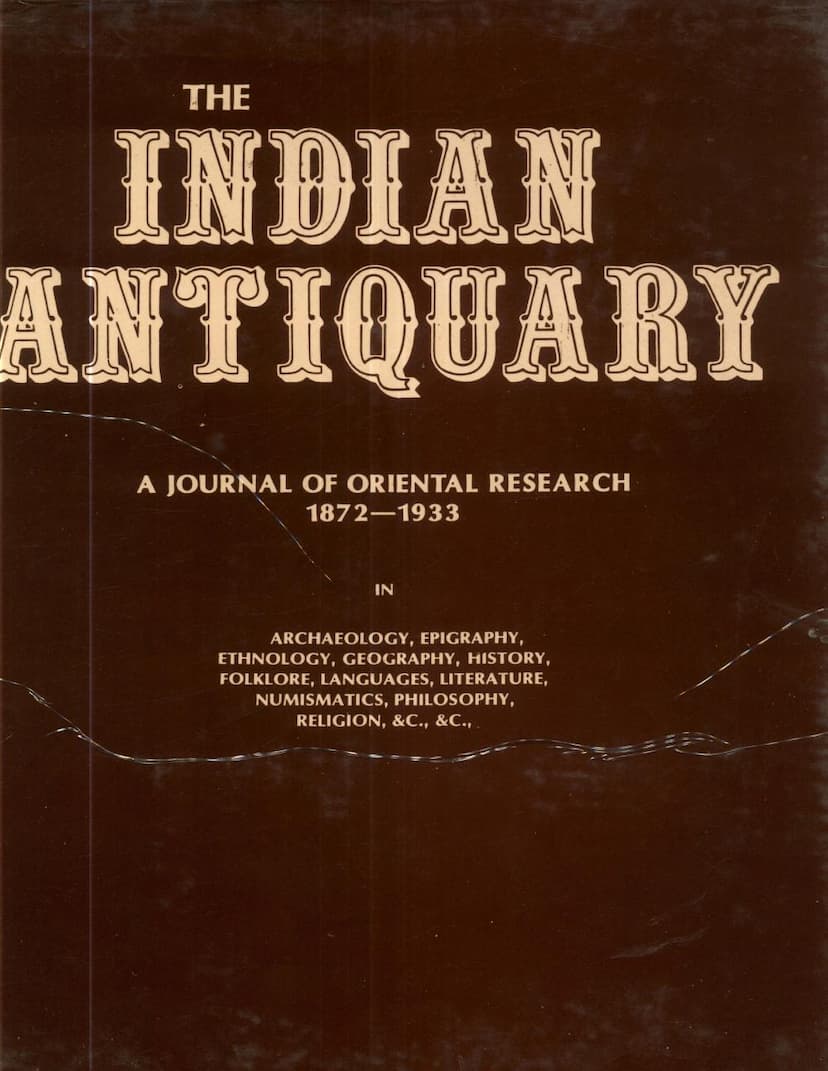Indian Antiquary Vol 01
Added to library: September 1, 2025

Summary
The Indian Antiquary, Vol. 1, published in 1872 and compiled by Jas. Burgess, is a foundational journal dedicated to the study and advancement of Indian culture in all its facets. Its extensive scope encompasses archaeology, epigraphy, ethnology, geography, history, folklore, languages, literature, numismatics, philosophy, and religion. The journal aimed to serve as a vital communication medium for Orientalists and archaeologists across India and the West, providing a platform for original contributions, notes, queries, reviews, and selections from various sources.
Key aspects of the Indian Antiquary, Vol. 1, as revealed in this volume, include:
- Broad Scope and Vision: Founded by Jas. Burgess, the journal was envisioned by its editor to cover "as wide as possible" the spectrum of Indian culture, from manners and customs to arts, mythology, antiquities, and history. It sought to study "MAN—The Indian—in all the spheres of activities of his day to day life, past and present."
- Bridging East and West: The journal actively aimed to bridge the cultural divide between the East and West by translating and abstracting research from German, French, and other foreign languages, making it accessible to Indian scholars. It also drew attention to articles of interest from other Asiatic societies.
- Diverse Contributors: The first volume features contributions from a wide array of scholars and officials from various backgrounds, including British Civil Servants (B.C.S.), academics like Professors from Elphinstone College and Bombay University, Reverends, and esteemed Indian scholars like Ramkrishna Gopal Bhandarkar and Rajendralala Mitra. This collaborative effort ensured a multi-faceted exploration of Indian subjects.
- Key Themes and Topics: The contents of Vol. 1 are remarkably diverse, reflecting the journal's comprehensive vision. Some of the prominent themes explored include:
- Archaeology and Epigraphy: Detailed analyses of copper-plate grants (e.g., from Balasor, Valabhi, and Tidgundi), inscriptions (e.g., Ganjam Rock-Inscription, Dondra Inscription), ancient alphabets, architectural remains (e.g., Nalanda Monasteries, Mathura sketches, Halabid Temple, Mandara Hill), and rock-cut monuments.
- History and Genealogy: Biographies of Mughal grandees, accounts of historical kingdoms like Magadha and Oudh, and discussions on the chronology of ancient texts like the Ramayana and the Puranas.
- Language and Literature: Studies on the position of Old Hindi in Oriental Philology, analysis of Sanskrit nominal bases, exploration of Dravidian literature, and the translation of various poems and legends.
- Folklore and Mythology: Accounts of local legends, proverbs, and customs from different regions such as Singhbhum, Northern Orissa, Dinajpur, Kathiawad, and the manners and customs of the Dard tribes (amusements, beverages, birth ceremonies, marriages, funerals, holidays).
- Religion: Explanations of Vedic words, discussions on serpent worship, and analyses of Buddhist scriptures.
- Numismatics and Geography: Notes on coins from Valabhi and Firuz Shah Zafar, and detailed explorations of ancient geographical locations, particularly those visited by the Chinese pilgrim Chi-Fah-Hian in Magadha, and the geography of Afghanistan and the Punjab in relation to Panini.
- Illustrations and Facsimiles: The journal incorporates various illustrations, including maps of the Jungle Forts of Northern Orissa, facsimiles of inscriptions on copper-plates, and woodcuts, significantly enhancing the scholarly value of the content.
- The Role of Native Scholars: The journal actively promoted the work of native Indian scholars, presenting their research and perspectives alongside those of their Western counterparts, thus fostering a truly collaborative and inclusive approach to Oriental research.
- Engagement with the Reader: The inclusion of a "Notes and Queries" section actively encouraged reader participation, fostering discussion and the dissemination of information on specific points of interest or difficulty.
In essence, the Indian Antiquary, Vol. 1, laid the groundwork for a systematic and scholarly exploration of India's rich cultural heritage, setting a high standard for future research in the field of Oriental studies.